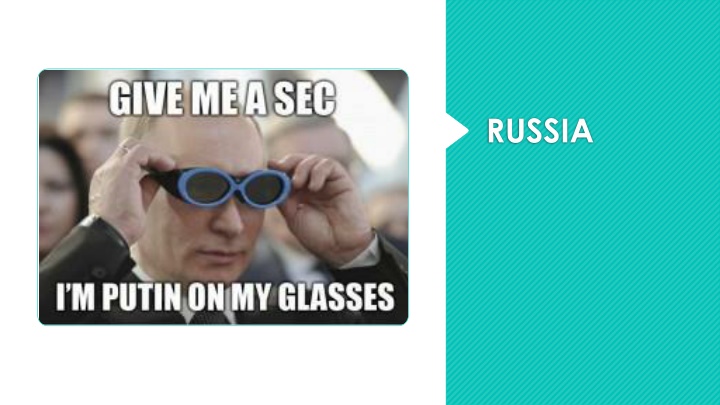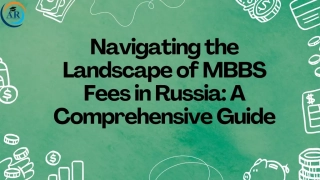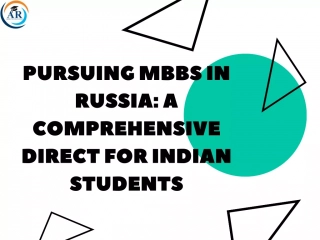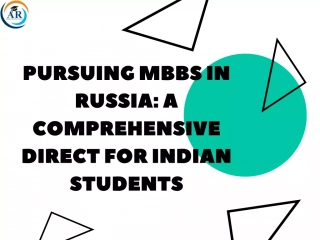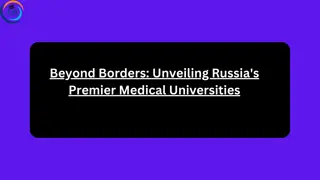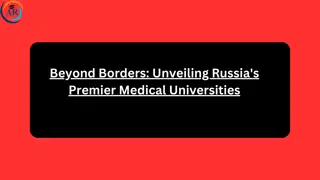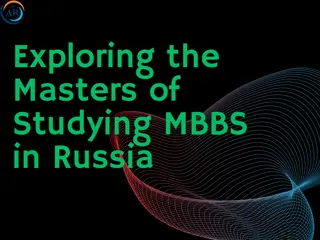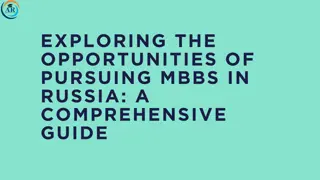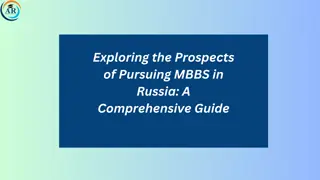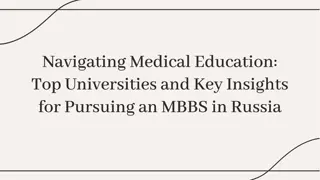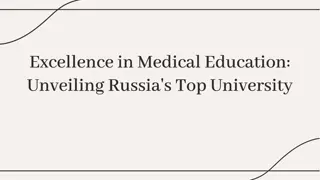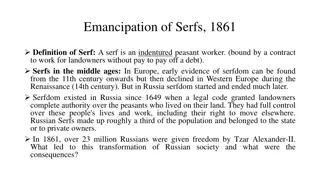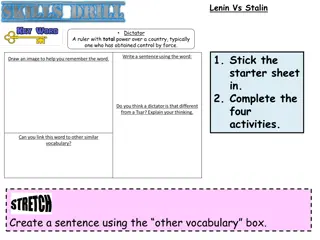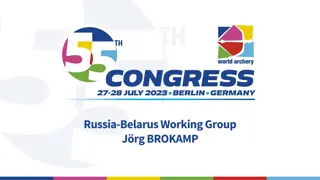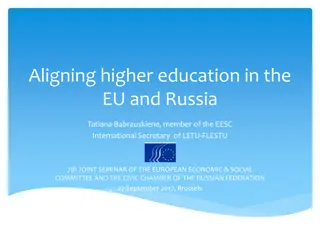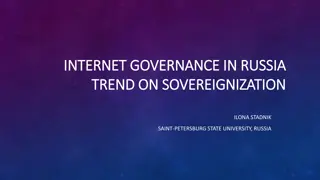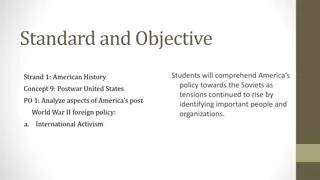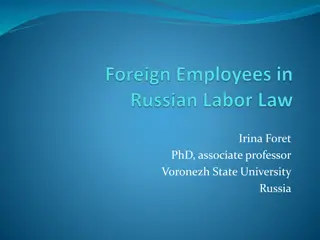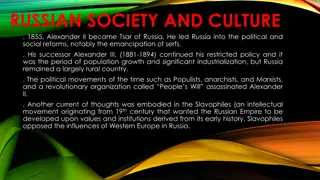Brief History of Russia: From Tsars to Soviets
Russia's rich history unfolds from the rule of the Tsars to the establishment of a communist regime under Lenin. Dive into the evolution of the largest European country, its monarchy, Soviet Union era, and modern governance led by Putin. Explore the societal shifts, revolutions, and challenges faced by Russia across different regimes, shaping its complex identity and global significance.
Download Presentation

Please find below an Image/Link to download the presentation.
The content on the website is provided AS IS for your information and personal use only. It may not be sold, licensed, or shared on other websites without obtaining consent from the author.If you encounter any issues during the download, it is possible that the publisher has removed the file from their server.
You are allowed to download the files provided on this website for personal or commercial use, subject to the condition that they are used lawfully. All files are the property of their respective owners.
The content on the website is provided AS IS for your information and personal use only. It may not be sold, licensed, or shared on other websites without obtaining consent from the author.
E N D
Presentation Transcript
The Russian Context Largest European country population 142.5 million Largest country in the world in area spans 11 time zones Russian Currency the Rouble Rich in Natura Resources concentrated in Siberia and Northern Russia Gold, Diamonds, Timber, Oil, Natural Gas Multiethnic state Size makes it difficult to govern Many areas uninhabitable
Regime Change v. Government Change Regime Change Government Change Monarchy The Tsars Soviet Union Communism The Soviet Union Lenin Stalin Khrushchev Gorbachev The Russian Federation Republic Republic Russia under Putin Hybrid Yeltsin Putin Medvedev Putin
Russia under the Tsars Patrimonial State the ruler treats the country as their personal property Autocracy Feudal type system the nobles owned the land and the peasants worked the land (serfs) Serfs emancipated in 1861 under Tsar s modernization efforts Modernized in late 1800s to stay in competition with the West Russia is defeated in the Russo- Japanese war Tsars become increasingly repressive Revolution breaks out in 1905 and in March 1917 the Tsar is overthrown and provisional government created October 1917 Lenin and the Bolsheviks overthrow provisional government and institute a communist regime
The Soviet Union under Lenin Marxists believed they were champions of the proletariat Slogan Land, Peace, and Bread Democratic Centralism = a mandated hierarchical party structure elected from the people (implemented in China as well) Vanguardism = a political party that claims to operate in the true interests of the class it represents (in this case the proletariat) this is regardless of the actual expressed interests of the people
The Soviet Union under Stalin Rapid economic development complete command economy Collectivization = agricultural land was removed from private ownership and organized into large state owned farms Isolationist avoiding working with the outside world Joined the allied powers after Hitler invaded lost 27 million people Got a spot on the security council in the UN NATO created after WWII to stop Soviet aggression Soviet Union creates the Warsaw Pact in response Start of the Cold War
The Cold War and the Soviet Bloc 2 superpowers US and USSR Conflict between Democracy and Communism No actual war only proxy wars like Korean War, Vietnam War, conflict in South America Lasts from 1945 (post-WWII) to 1989 (Fall of the Berlin Wall)
Modernization and De-Stalinization From 1953-1985 the Soviet Union attempts to de-Stalinize the country Khrushchev rejected terror as an instrument of political control Put the KGB under control of the party Still controlled by the Communist party with uncontested elections 1970s diverted resources to the military to keep up militarily with the US Liberalization in Eastern Europe helped expose Russian citizens to Western culture
Perestroika and Glasnost Gorbachev Perestroika = economic restructuring Glasnost = openness Once Gorbachev opened the door for dissent many of the autonomous regions in the USSR wanted independence Latvia, Lithuania, Estonia, Ukraine, Georgia, Armenia, and Moldova Both policies failed and weakened the Soviet Union Lost domestic support but won a Nobel Peace Prize internationally
2 3 4 1 Gorbachev recruits Boris Yeltsin into the Politburo (top Party organ) 1991 Yeltsin helps a coup d etat that declares the Soviet Union over and introduces the Russian Federation as a member of the Commonwealth of Independent States Yeltsin starts radical reforms proclaims commitment to Western-style democracy and market economic reform Proved hard to implement 1993 bloody showdown over a new Russian constitution Yeltsin disbands parliament, calls new parliamentary elections, and calls a referendum on the new constitution referendum passes Fall of the Soviet Union
The Russian Constitution Chapter 1 establishes a federal republic, illegal to overthrow government, creates a social state with guaranteed minimum wage, state pensions, and social welfare, protects private property, protects ideological diversity no state ideology like communism, separates church and state no official religion Chapter 2 inalienable human rights, due process men and women and minorities all equal under the law, no torture or humiliating punishments, right to life (death penalty allowed), right to privacy, freedom of movement, freedom of religion, freedom of expression (unless it causes unrest), freedom of association and assembly, right to join trade unions, right to own property, right to strike, labor rights, children s rights, right to healthcare, free education, right to counsel, presumption of innocence, no double jeopardy, no self-incrimination, duty to pay taxes, duty to protect the environment, draft with conscientious objection, allows dual citizenship, allows political asylum, will not extradite unless violates Russian law Chapter 3 Russian official language, protects use of native languages The rest of the chapters detail the federal structure and the powers of the 3 branches of government
The Rise of Putin https://www.pbs.org/wgbh/frontline/film /putins-way/ 1999 Yeltsin appoints Putin as Prime Minister Yeltsin resigns and Putin becomes acting President Elected in 2000 served 2 terms Stepped down to become Prime Minister for 1 term Ran for President again in 2012 Extended Presidential terms to 6 years Won reelection in 2018
The Executive Selection and Removal Head of State Head of Government Title/Current Name Prime Minister Mikhail Mishustin (Medvedev stepped down early January 2020 along with rest of government) Method of Selection Appointed by the President and approved by the Duma Length of Term When new President is elected Term Limit When new President is elected Removal 2 repeat no confidence votes in 3 month period Putin s Prime Ministers are not typically removed because it could lead to him dissolving the Duma and calling new elections May be dismissed by President at any time Title/Current Name President Vladimir Putin Method of Selection 2 round majority If no one receives a majority in the first round (50%+1 vote) there is a run-off with the top 2 candidates until someone gets a majority Putin received 53% in 2000, 72% in 2004, 64% in 2012, 77% in 2018 Medvedev got 71% in 2008 Length of Term 6 years (changed from 4 years in 2012) Term Limit 2 consecutive terms Removal Impeachment for treason or high crimes
The Executive - Powers Head of State President Putin Announces Elections of the Duma Selects the Prime Minister with approval from Duma Can dissolve the State Duma (automatically dissolves if they reject his suggestion for PM 3 times) Can submits laws to the Duma Signs or vetoes laws Can suspend the Executive Branch Signs treaties, chief diplomat Grant Pardons Decide issues of citizenship Issues edicts (like Executive Orders) Immunity from the law Head of Government PM Mishustin Proposes deputy chairs and ministers to the President to be appointed to the government Implements laws of the legislature Reports to the Duma about government activities Heads sessions of government Serves a mainly administrative role
Homework Read Foreign Policy Article Who is Russia s New Prime Minister? Answer the following questions: What do you think Putin s plan is for having the government resign? How do you think he might change the constitution to consolidate his power? Why do you think he selected Mishustin as his new Prime Minister replacing Medvedev?
The Military Commander in Chief President Putin Role of the Military: Military very important under Putin Increased security forces after terrorist attacks in Moscow Some terrorist attacks originated in Chechnya by separatists Justified restrictions on civil liberties in favor of increased security Military has lost some popular support because it has not been able to deal with Chechnya successfully Role of the Civilian Police and Federal Security Service Putin former KGB KGB turned into Federal Security Service Many people believe that local police are corrupt The Federal Security Service is used many times when the army cannot handle something High crime rates lead citizens and business to turn to private security firms for protection Federal Security Service has been accused of assassinating critics abroad
2006 Assassination of Alexander Litvinenko Former Federal Security Service agent outspoken critic of Russian Government Took political asylum in the UK Fatally poisoned in November 2006, on his deathbed accused the Kremlin (Russian Government) of killing him UK attempted to extradite former KGB agent Andrei Lugovoi Russian government refused to prosecute Led to an expulsion of diplomats from both countries https://www.independent.co.uk/news/uk/crime/alexander-litvinenko-death-inquiry-report- kremlin-russia-vladimir-putin-poisoning-live-updates-a6824571.html
The First Chechen War Chechnya annexed by Russian Empire in 1870s Under Stalin, more than 500,000 Chechens and other peoples of the Caucus region were ethnically cleansed and others deported to Siberia Khrushchev allowed the Chechen to return to their homeland After collapse of the Soviet Union, Yeltsin attempted to maintain Chechnya as a territory with some autonomy, but Chechnya wanted independence declare independence in 1991 1994 Yeltsin sends Russian army in to restore constitutional order Full assault on Grozny, the capital of Chechnya air strikes and artillery shelling Caused awful destruction in the city and significant civilian casualties upwards of 40,000 Many human rights abuses against guerilla Chechen fighters torture, etc. Ends in a stalemate in 1996 Yeltsin calls a ceasefire Formal peace treaty signed in 1997
The Legislature Upper House Lower House Name: Name: Size: Size: Electoral System: Electoral System: Powers: Powers:
Ethnicity and Religion Ethnic Makeup: Russian 77.7% Other 14.1% Tatar 3.7% Ukrainian 1.4% Chechen 1% Religious Makeup: Russian Orthodox 41% Agnostic 25% Atheist 13% Muslim 7% Christian 4%
